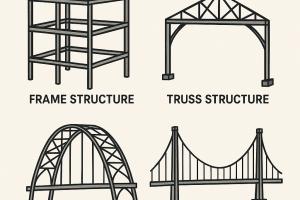Types of Failures in Steel Structures
Type of Failures in Steel Structures:
- Shearing Failure of Bolts.
- Bearing Failure of the plate.
- Tearing failure at the edge of the plate.
Shearing Failure of Bolt:
Shearing failure of bolts occurs when the applied load exceeds the bolt's shear strength. Bolts are commonly used to connect steel members and transfer loads between them. Shearing failure can happen in bolts subjected to high shear forces, such as in tension members or connections between beams and columns. The failure typically occurs along the shear plane of the bolt, resulting in the separation of the connected members.
To prevent shearing failure, engineers consider factors such as the shear capacity of the bolt, the number and size of bolts used, and the quality of the bolt installation. Adequate bolt sizing, proper tightening techniques, and ensuring appropriate edge distances and spacing between bolts are essential to resist shear forces and prevent this type of failure.
Bearing Failure of Plate:
Bearing failure of a plate occurs when the applied load exceeds the bearing capacity of the plate or the connected structural member. This failure mode is observed in connections where a plate is in direct contact with another surface, such as the flanges of a beam resting on a column or a gusset plate connecting beams or columns.
Bearing failure typically manifests as the crushing or deformation of the plate or the material being contacted. It can occur due to excessive pressure or stress concentrations at the contact points. To prevent bearing failure, engineers consider the thickness and strength of the plate, the contact area, and the material properties of the connected members. Proper design and detailing of the connection, including ensuring adequate bearing lengths and providing suitable reinforcements, are crucial in mitigating this type of failure.
Shear & Bearing Area
Shear area refers to the portion of a structural element that is subjected to shear forces. It represents the area of the member that actively resists shear stress and contributes to its shear capacity.
Bearing area refers to the surface area of contact between two structural elements that transmit compressive forces. It is crucial for proper load transfer and preventing bearing failure, which occurs when compressive stresses exceed the bearing capacity of the material.
The shear area is about the portion of the member that resists shear forces while the bearing area is about the contact surface between two elements that transmit compressive forces. Both areas play essential roles in the design and analysis of steel structures.
Tearing Failure at the edge of the Plate
Tearing failure at the edge of a plate, also known as edge tearing or tearing failure, occurs when the applied load causes the material near the edge of the plate to tear or fracture. This failure mode is commonly observed in welded connections or in plates subjected to high tensile or bending loads.
Tearing failure is influenced by factors such as the plate thickness, the material's ductility, and the presence of stress concentrations. Inadequate design, including insufficient plate thickness or inadequate reinforcement, can lead to localized stress concentrations and initiate tearing failure. To prevent this type of failure, engineers consider the design provisions for edge distance, weld quality, and the use of suitable reinforcement, such as stiffeners or fillet welds. Proper welding techniques and weld quality control are essential to resist tearing forces and ensure the integrity of the steel structure.
Shearing failure of bolts, bearing failure of plates, and tearing failure at the edge of plates are common types of failures observed in steel structures. By considering factors such as material properties, load conditions, and appropriate design provisions, engineers can prevent these failures and ensure the safe and reliable performance of steel structures. Adequate attention to bolt shear strength, plate bearing capacity, and reinforcement at plate edges play a vital role in mitigating these failure modes.
The eccentricity of Applied Force:
Plates of lap joint tend to bend.
Bending produces nonuniform bearing of the fastener on the plates
Tearing Failure
Tests showed, failure by tearing through free edge of material will not occur if Le measured parallel to line of applied force is not less dia of bolt multiply ratio of bearing stress to tensile strength of connected part.
Force transmitted by the bolt
P = fp D t ------------------------(A)
Force to cause failure along two shear planes
P = 2(Le - D / 2 ) t u
u = 0.7 Fu
P = 1.4Dt Fu (Le / D -1/2) -----(B)
Equating (A) & (B)
Equation ( C ) can be approximated as
So Equation becomes;





